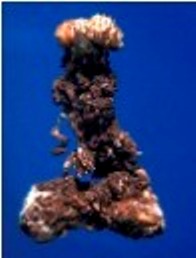Classification
Who am I? Classification
Being the missing piece to something is no easy feat. Not only are you hard to find, but there isn't much information about your classification that isn't controversial. As you go farther on into the classification of Cordyceps subsessilis, you may notice that the family and the genus can be classified in two different ways. The second way is in accordance to an experiment done by Gi-Ho Sung (and others) where they determined a classification method for most of the fungi in the Cordyceps genus and the Clavicipitaceae family. The article for this experiment can be found here.
Cordyceps subsessilis is classified into these groups:
Domain- Eukarya
Kingdom-Fungi
Phylum-Ascomycota
Class- Sordariomycetes
Order-Hypocreales
Family-Clavicipitaceae (Ophiocordycipitaceae)
Genus-Cordyceps (Elaphocordyceps)
Species- C. subsessilis (E. subsessilis)
Cordyceps subsessilis is in the domain Eukarya because its cells
have a nucleus, nuclear envelope, membrane-bound organelles, its genetic
processes are mitosis and fertilization. If C. subsessilis did not
have membrane-bound organelles and did not have a true nucleus, it would be
either a member of the Archaea or the Bacteria.
Cordyceps subsessilis is in the fungi kingdom because it is heterotrophic, it digests then ingests, has cell walls made of chitin, uses spores as means of reproduction, have an alternation of generations life cycle, and has both sexual and asexual reproduction. An indicator of the kingdom Plantae is that they are autotrophic, which means they produce their food by photosynthesis, so it could not possibly be a member of kingdom Plantae. C. subsessilis could not also be a member of kingdom Animalia because it exhibits an alternation of generations life style.
C. subsessilis is a member of the
phylum, Ascomycota, because they have asci in their fruiging body, an ascocarp,
and an asexual stage that produces its spores externally on conidia. An
asci is a sac-like structure which holds sexuall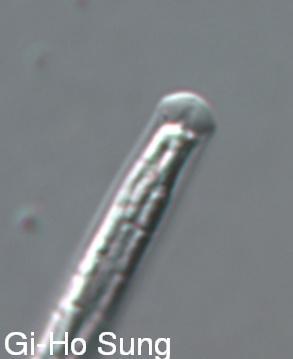 y
produced spores which are internally born in the asci. The ascocarp is the
fruiting body of the Ascomycete where the asci are held. The ascocarp is
actually the part of
Cordyceps subsessilis that is above ground and what we commonly picture
when we think of the fungus. If the spores weren't held in sac-like asci,
it wouldn't be considered a member of this phylum.
y
produced spores which are internally born in the asci. The ascocarp is the
fruiting body of the Ascomycete where the asci are held. The ascocarp is
actually the part of
Cordyceps subsessilis that is above ground and what we commonly picture
when we think of the fungus. If the spores weren't held in sac-like asci,
it wouldn't be considered a member of this phylum.
Ascomycota are very versatile organisms. One aspect of their versatility is that they are able to form mutualistic symbiotic relationships with other organisms! A lichen is a relationship between an fungus and either a green algae or a cyanobacteria. These relationships help establish life in even the most impossible places. To learn more about algae, click here!
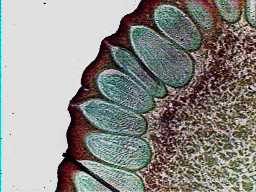 Being a member of the Sordariomycetes (sometimes referred
to as the Pyrenomycetes) class means that Cordyceps subsessilis
produces a perithecial fruiting body, the asci are formed in only one layer,
there is only one hole in the asci to allow for spore release, and the conidia have no color and are rather powdery looking. Being
perithecial means that the fungus is in the shape of a round ball.
Being a member of the Sordariomycetes (sometimes referred
to as the Pyrenomycetes) class means that Cordyceps subsessilis
produces a perithecial fruiting body, the asci are formed in only one layer,
there is only one hole in the asci to allow for spore release, and the conidia have no color and are rather powdery looking. Being
perithecial means that the fungus is in the shape of a round ball.
As a part of the Hypocreales order, this fungus has bright colors that make up its ascocarp (or fruiting body that holds the spores). Most fungi in this group also have one or more anamorphs. This is the same case for Cordyceps subsessilis because it, too, has an anamorph.
The Clavicipitaceae family is very interesting because it
generally just includes obligate parasites. This means
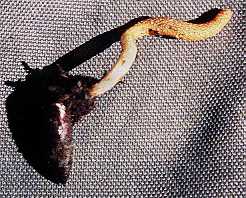 that
these organisms only take their nutrients from other organisms by harming them
in some way. Cordyceps subsessilis takes its nutrients by living on
a beetle larvae. It has been called Ophiocordycipitaceae by Sung (et. al.)
because after doing some molecular studies on these groups, he found out that
Clavicipitaceae in itself was not a monophyletic group (meaning that these
organisms had more than one ancestor, therefore are not as closely related as
thought to be). He also found out that Clavicipitaceae could be broken
down into three monophyletic groups, coming up with the Ophiocordycipitaceae. Most of the Ophiocordycipitaceae produce darkly
colored stromata and are known to be parasites of organisms that are buried in
the soil or decaying wood.
that
these organisms only take their nutrients from other organisms by harming them
in some way. Cordyceps subsessilis takes its nutrients by living on
a beetle larvae. It has been called Ophiocordycipitaceae by Sung (et. al.)
because after doing some molecular studies on these groups, he found out that
Clavicipitaceae in itself was not a monophyletic group (meaning that these
organisms had more than one ancestor, therefore are not as closely related as
thought to be). He also found out that Clavicipitaceae could be broken
down into three monophyletic groups, coming up with the Ophiocordycipitaceae. Most of the Ophiocordycipitaceae produce darkly
colored stromata and are known to be parasites of organisms that are buried in
the soil or decaying wood.
Another organism that is a member of this family is Claviceps purpurea, the Ergot. If you would like to know more about the medicinal uses and parasitic states of this organism click here!
Then comes the Cordyceps genus. This genus is
known to have perithecia (a structure containing asci) either on the surface or
completely buried on the stipe, cylindrical asci that have thick apices (very
top part of ascus), and a round or a
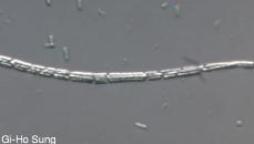 club-shaped stromata (the top part of the
stipe). In regards to the spores,
they tend to form thread-like structures then break apart into part-spores. Sung (et. al.) also had something to change here. Instead of having just a full
Cordyceps group, he broke it down into smaller clades.
The genus he proposed was Elaphocordyceps. Elaphocordyceps tend to
parasitize the Elaphomyces (cup fungi) as well as some nymphs of cicadas.
A lot of the categorization is due to molecular data and microbiology.
club-shaped stromata (the top part of the
stipe). In regards to the spores,
they tend to form thread-like structures then break apart into part-spores. Sung (et. al.) also had something to change here. Instead of having just a full
Cordyceps group, he broke it down into smaller clades.
The genus he proposed was Elaphocordyceps. Elaphocordyceps tend to
parasitize the Elaphomyces (cup fungi) as well as some nymphs of cicadas.
A lot of the categorization is due to molecular data and microbiology.
Finally, we have the organism species itself,
Cordyceps subsessilis. This guy is different from the rest of the
Cordyceps genus because it has a white,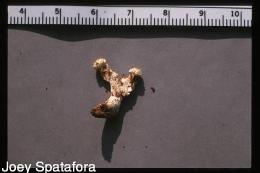 abnormally shaped, and tend to have no stipe to a small, abnormally shaped one. Perithecia tend to be thinly
ovoid or conoid with brownish or yellowish walls. Elaphocordyceps
subsessilis is also different because it does not parasitize the average
Elaphomyces but instead feeds upon a Coelopteran larva. This organism is
also different from the rest of the Elaphocordyceps genus because of the way it
looks and the way it lives. It is only included in the genus because of
its molecular data.
abnormally shaped, and tend to have no stipe to a small, abnormally shaped one. Perithecia tend to be thinly
ovoid or conoid with brownish or yellowish walls. Elaphocordyceps
subsessilis is also different because it does not parasitize the average
Elaphomyces but instead feeds upon a Coelopteran larva. This organism is
also different from the rest of the Elaphocordyceps genus because of the way it
looks and the way it lives. It is only included in the genus because of
its molecular data.
Phylogenetic Trees
This phylogenetic tree is about the phylums of fungi and their closely related relatives, the Nucleariids. The Nucleariids are supposedly the organisms that the fungi are evolved from. They are included on here because of that particular fact. Moving on, we come upon the oldest phylum, the Chitridiomycota. These fungi are the oldest because they have motile spores. They are the only fungi to exhibit this trait anymore. The spore has a small flagella with a couple mitochondria by it for powering locomotion. The next phylum would be the Glomoromycota. These fungi exhibit relationships with plants in that they form endomycorrhizae. Endomycorrhizae are where the fungus is able to grow in between and inside the cells of the plant. This is beneficial to both the plant and the fungus as the plant is able to receive nutrients from the fungus, and in turn the fungus receives energy. The next phylum in this tree is the Zygomycota. These fungi are interesting because they have both asexual and sexual reproductive states, and in their sexual reproduction, they produce structures called zygospores. Zygospores form when two hyphae of opposite sex come together and share their nuclei. This then forms a hard, round spore that sits between the two hyphae. As we continue on through this tree, we come upon the Basidiomycota. This phylum is commonly what you would associate the word mushroom with. Their sexual state consists of a fruiting body with spores that are protected under the cap. The spores are produced externally on club-shaped structures called basidia. Also, this phylum generally does not have an asexual state. The last phylum, and the one that Cordyceps subsessilis belongs to is the Ascomycota. These fungi also form fruiting bodies, but unlike the Basidiomycota, their spores are produced internally (as we learned above). Another interesting factor
As can be seen, there are five definite groups of fungi. Not shown on here is a group of fungus that are considered to be almost unidentifiable. These fungi are put into the deuteromycetes because they don't have any sexually producing state. A lot are thought to be a part of the Zygomycota, but at the moment they haven't found much evidence to track them back to that.
If this topic is intriguing to you, continue on to learn more about Cordyceps subessilis's habitat by clicking here!
If this is not your cup of tea, click here to return home!
